
Melaleuca viminalis, commonly known as weeping bottlebrush, or creek bottlebrush is a plant in the myrtle family, Myrtaceae and is endemic to New South Wales, Queensland and Western Australia. It is a multi-trunked, large shrub or tree with hard bark, often pendulous foliage and large numbers of bright red bottlebrush flowers in spring and summer. It is possibly the most commonly cultivated melaleuca in gardens and its cultivars are often grown in many countries.

Melaleuca linearifolia, commonly known as netted bottlebrush, is a plant in the myrtle family, Myrtaceae and is endemic to New South Wales in Australia.. It is a shrub with narrow, pointed leaves and red flower spikes in spring or summer.
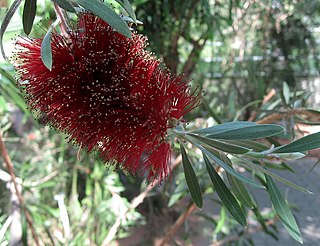
Melaleuca pachyphylla, commonly known as wallum bottlebrush, is a plant in the myrtle family, Myrtaceae and is endemic to near-coastal regions of New South Wales and Queensland in Australia. It is a medium-sized shrub with a straggling habit and red, or sometimes greenish bottlebrush flowers in summer.

Melaleuca pityoides, commonly known as alpine bottlebrush, is a plant in the myrtle family, Myrtaceae and is endemic to the higher areas of south eastern Australia.. It is a shrub, often occurring in dense thickets, with hard bark, silvery-grey new growth, almost cylindrical leaves and spikes of flowers that are usually a shade of yellow.

Melaleuca williamsii is a plant in the myrtle family, Myrtaceae and is endemic to an area between north-eastern New South Wales and south eastern Queensland in Australia. It is a distinctive shrub with stiff branches, silvery new growth, prickly leaves and spikes of purple flowers in late spring. It is classified as a vulnerable species under the Australian Government Endangered Species Protection Act.
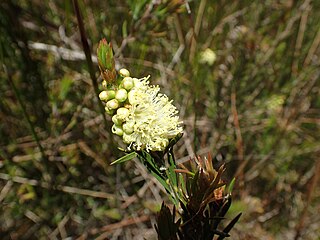
Melaleuca paludicola, commonly known as river bottlebrush, is a plant in the myrtle family, Myrtaceae and is endemic to eastern Australia. It is a shrub or small tree with flexible, often drooping branches, pinkish new growth and spikes of cream, pale yellow, or sometimes pink flowers in summer.

Melaleuca subulata is a plant in the myrtle family Myrtaceae, and is endemic to south eastern Australia.. It is a small, spreading shrub with hard bark, dense foliage, cylindrical leaves and spikes of dark crimson flowers in summer.

Melaleuca orophila, commonly known as needle bottlebrush or Flinders Ranges bottlebrush, is a plant in the myrtle family, Myrtaceae and is endemic to the eastern part of South Australia.. It is a medium-sized shrub with sharp-pointed, needle-like leaves and bright red bottlebrush flower spikes.
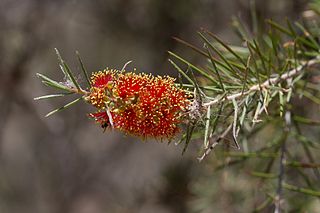
Melaleuca brachyandra, commonly known as prickly bottlebrush or scarlet bottlebrush, is a plant in the myrtle family, Myrtaceae and is endemic to New South Wales, Victoria and South Australia in Australia. It is a shrub or small tree with narrow leaves and showy red and green flowers making it an ideal ornamental plant in temperate areas.

Melaleuca faucicola commonly known as desert bottlebrush, is a plant in the myrtle family, Myrtaceae and is endemic to the Northern Territory in Australia. It is a shrub or small tree growing only in protected gorges in the ranges of Central Australia such as the Petermann Ranges and has red, cream or white spikes of flowers.

Melaleuca pallida, commonly known as lemon bottlebrush, is a plant in the myrtle family, Myrtaceae and is endemic to eastern Australia. It is an upright shrub with thin, spreading branches, silvery new growth and pale yellow, sometimes pinkish bottlebrush flowers.
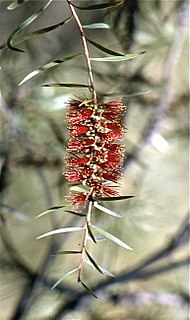
Melaleuca chisholmii commonly known as Burra bottlebrush is a plant in the myrtle family, Myrtaceae and is endemic to Queensland. It is a shrub with rough bark, an open habit and spiky foliage but in winter has bright red flower spikes tipped with yellow.

Melaleuca flammea, commonly known as tapering-leaved bottlebrush, is a plant in the myrtle family, Myrtaceae and is endemic to New South Wales and Queensland in Australia. It is a shrub with broad, lance-shaped leaves which have wavy edges and taper gradually to a fine point. In spring it has typical bottlebrush flowers whose fiery colour gives the species its name.
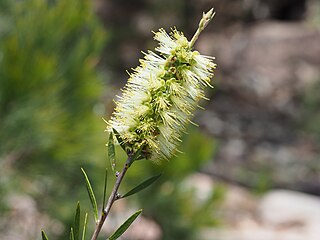
Melaleuca flavovirens, commonly known as green bottlebrush is a plant in the myrtle family, Myrtaceae and is endemic to a small area near the New South Wales–Queensland border in Australia. It is a stiff shrub, distinguished by its silvery new growth and spikes of greenish flowers with yellow tips.

Melaleuca formosa, commonly known as Kingaroy bottlebrush or cliff bottlebrush is a plant in the myrtle family, Myrtaceae and is endemic to a small area in Queensland and peripherally in New South Wales, Australia. It is a shrub with weeping branches and spikes of lemon-coloured flowers in spring.
Melaleuca hemisticta, commonly known as Mount Wheeler bottlebrush is a plant in the myrtle family, Myrtaceae and is endemic to coastal areas of Queensland. It is a tall, bushy shrub with dark green leaves and red flowers spikes tipped with yellow.
Melaleuca lazaridis is a plant in the myrtle family, Myrtaceae and is endemic to the Blackdown Tableland National Park in Queensland.. It is a shrub with dark green leaves and red flowers spikes tipped with yellow.

Melaleuca megalongensis, commonly known as Megalong Valley bottlebrush, is a plant in the myrtle family, Myrtaceae and is endemic to New South Wales.. It is a shrub similar to Melaleuca citrina which occurs in the same area and is difficult to distinguish from it, except when in flower.

Melaleuca montana, commonly known as mountain bottlebrush, is a plant in the myrtle family, Myrtaceae and is endemic to the Border Ranges area of New South Wales and Queensland in Australia.. It is a shrub or small tree distinguished from most other red bottlebrushes by its hairy petals.

Melaleuca shiressii is a plant in the myrtle family, Myrtaceae and is endemic to a small area in New South Wales in Australia. It is rare shrub or small tree with pale, papery bark, sharp-pointed leaves and spikes of white to pale cream bottlebrush flowers in spring and summer.























